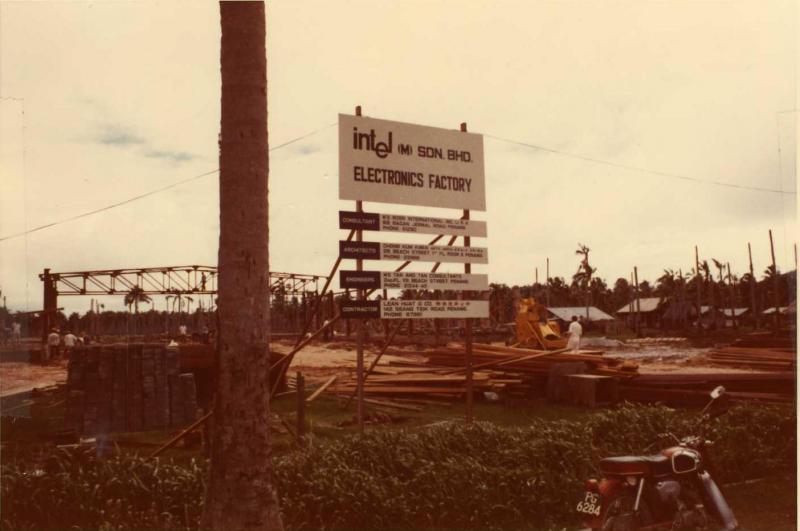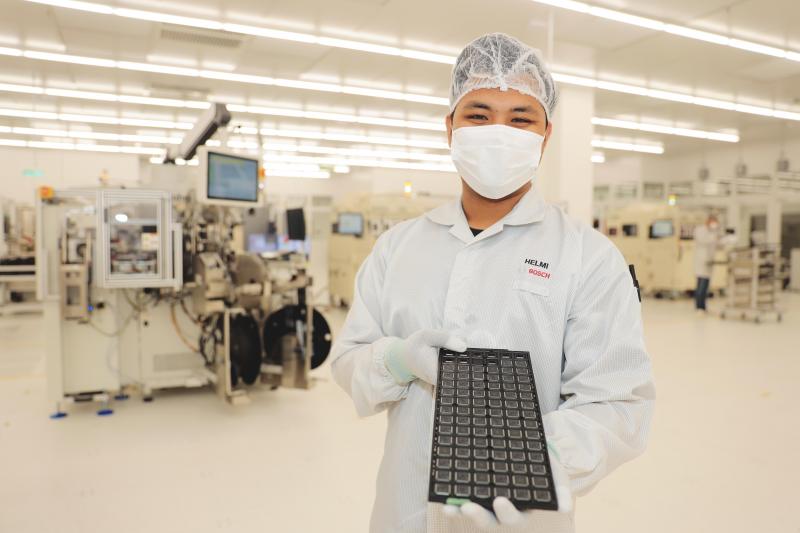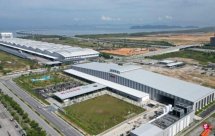
Malaysia is a semiconductor supply chain of the world.The Sino -US trade war prompted a global semiconductor manufacturer to enter the Malaysian country for decentralized risks.Among them, Penang has become the first choice for foreign investment to enter Malaysia with years of industrial foundation.Malaysia is preparing to pursue the victory, comprehensively develop the upstream industry of high -value -added semiconductor value chains, and spill the semiconductor industry to other states, but also faces the restrictions of lack of talents and technology.
In recent years, global semiconductor giants have been transferred to Southeast Asian factories due to competition between China and the United States, making Malaysia an unexpected winner.Among the states of Malaysia, Penang, which enjoys the reputation of "Oriental Silicon Valley", has become a focus of multinational enterprises.
Penang attracted a total of $ 12.8 billion (about S $ 17.2 billion) last year, which exceeded the sum of the first seven years.Among them, Intel spent $ 7 billion to build a new plant in Penang, Micron opened the second assembly and test plant in Penang, and Infineon plans to invest $ 5.4 billion in expansion facilities in the next five years.
Cao Guanyou, Chief Minister of Penang, said in an interview with Lianhe Morning Post that Penang's semiconductor industry has risen again in the past five years, which is the result of the combination of time and geographical interest.
He said that the United States tightened the exports of chips and related technology to China, prompting many large semiconductor factories to find new production bases outside China."This has benefited the geographical location in Southern Asia in the Asia -Pacific center and brought new opportunities to the semiconductor industry in Malaysia."
Chief Minister: Penang achievement is by no means an accidental foundation in more than 50 years of industrial foundation
Cao Guanyou emphasized that the global situation is beneficial, but Penang can stand out from accident, but based on the industrial basis for more than 50 years.
 />
/>
Francishutchinson, director of the Malaysia Research Project of Singapore's Susov Isa Erv Yasa Eastern Asia Research Institute, pointed out how Penang looked back at Penang's bloom through the electronics industry that Lin Cangyou worked as a chief minister in Penang in 1969 to improve improvement.The Penang economy, including the establishment of the state government to invest in the Penang Development Agency, mobilize all available resources stipulated in the Constitution. According to the recommendations of the Natan report in 1970, the electronics and electrical industries are vigorously developed.
Bayan Lepas in Penang became the first free trading zone in Malaysia in 1972, and the electronics and electrical manufacturing hubs in Penang and even Malaysia at that time.The first eight multinational companies invested in Penang that year were called "Eight Samurai", including national semiconductors, ultra -micro -micro, Intel, Osram, Hewlett -Packard, Bosch, Hitachi, and Ge Le.
By 1980, Penang attracted 25 electronic assembly companies to conduct business and manufactured 25,000 employment opportunities.By 1990, there were 500 international and local enterprises in Penang Industrial Park, hired 120,000.The continuous development of the manufacturing industry accounted for 47%of the GDP of Penang that year; in the country, this ratio was only 27%.In 2010, Penang had about 1,400 manufacturing companies to provide employment opportunities for 200,000 people. The manufacturing industry accounted for 46%of the GDP in Penang. Penang's per capita income was 17%higher than the national average.
Cao Guanyou said that although some companies have reorganized and renamed the "Eight Samurai" companies in the "Eight Samurai", they still continue to operate and expand their investment in Penang, highlighting the confidence of multinational companies in Penang.
"Penang has also continued to become the first choice of foreign investors in Malaysia. Recently, some investors told me that they would either invest in Penang, otherwise they chose countries outside Malaysia. I think this is Penang 50The advantages accumulated by many years of industrial development.
One of the "Eight Samurai" German Enterprise Bosch launched a business in Malaysia in 1923 and has the largest manufacturing facilities in Southeast Asia in Penang.
In August last year, Bosch added a semiconductor rear site to Penang to final test on automotive chips and sensors.As of December 31 last year, Bosch Malaysia's investment reached RM235 million (about S $ 67 million) and hired more than 4,000 employees.
Klaus Landhaeusser, managing director of the Malaysian Bosch, said in an interview that Bosch decided to build new facilities in Malaysia, mainly depends on the strategic advantages of Malaysia.
"As the sixth major semiconductor exporter in the world, Malaysia already has a very complete semiconductor ecosystem. Malaysia is an important participant in the semiconductor value chain in Southeast Asia and one of the fastest -growing economies in the world."
Ledis pointed out that Bosch's factories are mainly concentrated in Penang because Penang's basic elements such as the supervision of the electronics manufacturing industry, logistics efficiency, supply chain collaborative effect, and recruitment process are quite complete.
Another "Samurai" Intel's business in Penang has also become one of the most important production lines in the world.Intel entered Penang in 1972, only three years later, Penang's production capacity has accounted for more than half of Intel's global packaging capacity.Today, Intel's business in Penang has expanded to a scale of $ 5.9 billion. It has invested $ 7 billion in new facilities three years ago, the world's first advanced 3D chip packaging factory, which will be completed and put into operation this year.
The vice president and managing director of Intelma State said, "When you introduce cutting -edge technology, there will be a chain reaction to attract dozens of related new enterprises and help improve the overall skills of labor."
 />
/>
At present, Penang has 10 industrial parks, international airports, as well as logistics and distribution facilities, and also has equipment such as international schools, colleges and medical institutions, and medical care.
Semiconductors produced in Penang cover medical equipment, solar panels and electronic manufacturing services.Multinational companies enter Penang, and many SMEs have also become suppliers of these large semiconductor factories, promoting the development of local electronics and electrical industries.
The limitations of land and water supply must be overcome
The semiconductor industry is mainly divided into design, manufacturing, packaging and testing.The strength of Malaysia in the global semiconductor supply chain is packaging and testing, accounting for about 13%in the global semiconductor semiconductor semiconductor semiconductor testing market.
The packaging test refers to the process of obtaining an independent chip that will be processed according to the product model and functional processing through the test.This process must consume a lot of water.
 />
/>As a island, Penang has always faced the problems of water supply and land limited.Cao Guanyou admits that water supply is a severe challenge, especially climate change and river pollution incidents, which further affects Penang's water supply stability.
At present, Penang only meets 15 % of its water supply, and the rest must rely on the adjacent Kedah water supply.With the increase in demand, if Penang cannot solve the problem of water supply, the development of the semiconductor industry will be restricted.
The Penang government plans to complete a number of short -term and medium -term projects by 2028 to strengthen the water supply capacity in the state.Penang also plans to carry out the "South -to -North Water Diversion" project from the adjacent Perak, in order to solve the problem of water supply by 2030.
On the other hand, the Penang government is expected to develop all land by 2030.In order to solve the problem of insufficient land supply, the Penang Development Agency considers to increase land reserves through reclamation methods and study the recovery of about 12 square kilometers of land in the Welong province to open up new industrial parks.
Analysis: The advantages of each state can develop into a complete value chain
As the semiconductor becomes a key pillar of the Malaysian economy, many states in Malaysia also hope to split a share in the semiconductor industry.
Selangor is supported by the federal government, developing the largest integrated circuit design park in Southeast Asia, providing measures such as government subsidies, tax reduction and exemption visas to attract global science and technology factories and talents.This project is planned to operate from July this year, and the official hopes that Malaysia can become the global integrated circuit design industry center.
Sarawak Prime Minister Abonzohari also announced a few days ago that the establishment of Sarawak Microelectronics Design Company to invest in composite semiconductors and cooperate with British companies to build chip design centers in Sarawak.
On the other hand, Johor also ushered in the first semiconductor accessory manufacturer last year. It is expected to be put into operation in the fourth quarter of this year.
Some people are worried that joining the development of the semiconductor industry throughout Malaysia may affect Penang's status as a semiconductor center.Some analysts believe that there are their own advantages and deficiencies across the Malaysia country, and they can focus on different supply chain links and ultimately occupy a complete semiconductor value chain.
Cai Zhaoyuan, a senior financial analyst at Malaysia, pointed out in an interview that Penang's semiconductor ecosystem has been in place. Other states can use Penang models to achieve jump development.
He said: "There may not be a competitive relationship between states, but can exert their respective advantages, conduct semiconductor production in different fields, and strengthen Malaysia's overall competitiveness."
Cao Guanyou pointed out that the semiconductor ecological chain is quite extensive, and the integrated circuit design is just one of them.The Penang government will continue to attract more diversified investment, including cooperating with the federal government to introduce more integrated circuit design companies to make the ecological chain more complete.
Malaysia's high -tech technology is the biggest challenge
The semiconductor industry of Malaysia is mainly concentrated in the packaging and testing of downstream. The semiconductor test is at the end of the semiconductor value chain.The Malaysian government hopes to pursue the victory and promote the semiconductor industry to the high end of the value chain.
Wang Shoumi, chairman of the Malaysian Semiconductor Industry Association, said in an interview that the current demand for semiconductors is strong, and Malaysia should seize the opportunity to explore the upstream industries."We will be able to build a brand new upstream ecosystem and become the first country in Southeast Asia to have a complete semiconductor value chain."
 />
/>
However, semiconductor research and development and design involve huge funds and require high -end professional technologies, and Malaysia still has obvious deficiencies in terms of technology.
Harchinson of the Easov Isa Eastern South Asian Research Institute said that although many multinational companies engaged in complex businesses set up factories in Malaysia, they have little contact and interaction with local companies, and their technical transfer is limited.
"Because companies in Malaysia are less participating in value -added activities, this limits the potential of innovation, and Malaysia's development in wafer manufacturing is not enough."
Harchinsen said that Japan, South Korea and Taiwan can take the front end of the development of semiconductor development because they pursue improving technical ability and professional knowledge."Malaysia, Singapore, and Thailand have adopted different models, focusing on attracting investment, and did not actively participate in research and development and skills creation. Therefore, there is a technical gap."
Cao Guanyou pointed out that many of the large companies who have invested in Penang in recent years have been engaged in chip design business, and Penang companies have been able to learn from these large companies."We have also seen more and more local companies that rise, of which Skyechip and OPPSTAR have begun to design and test business."
Improve the salary of local engineers and actively attract overseas talents
"Penang will continue to strengthen the development of downstream industries, and also actively develop the upstream industry. This is what we want to do most."
Malaysia is to enter the upper reaches of the value chain of the semiconductor, and it must compete with talents with the global market.
Ledis pointed out that the semiconductor industry needs to engage in engineers in chip design, manufacturing, marketing, sales and management, but Malaysia is very lacking in talent in this area."Malaysian talents also tend to choose higher salary work overseas, and it is very difficult to recruit proficient foreign talents, which exacerbates the problem of Malaysian talent shortage."
At present, the number of graduates of Malaysia in the field of science, technology, engineering and mathematics (STEM) is still less than 60 %.In order to fill in lack, the official is strengthening the cultivation of talents in the field of science and technology through improving technology and vocational education training.
 />
/>
The global semiconductor field is facing fierce talent competition, and Malaysia's salary is low, so that many engineers have flowed out over the years.
Cao Guanyou said that the Malaysian government has realized the problem and began to try to increase salary."At present, the starting salary of graduates of university engineering has been raised from more than RM3,000 to RM4500. The government has also set up scholarships to promote vocational training. These are our efforts to overcome talent shortages."
He calls on employers to cooperate to increase the salary of engineers, otherwise talent loss will eventually affect corporate competitiveness.
Malaysia also hopes to attract external talents and encourage overseas expertise to return.
Cao Guanyou said that Penang has developed industry for many years and has cultivated outstanding talents for many multinational companies."When I visited some large manufacturers in Penang, I found that except for a small number of executives of foreigners, everything else is Malaysians. This shows that there are local talents. We have to attract them to serve local companies.Essence"
He said that in order to attract talents to return, the government will increase support for starting companies and encourage people to return to China to start a business.
"We hope that one day, Malaysian companies can also become large semiconductor companies. Otherwise, Malaysians will always be cheap workers for multinational companies, which is not what we want to see."



